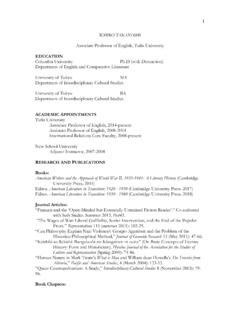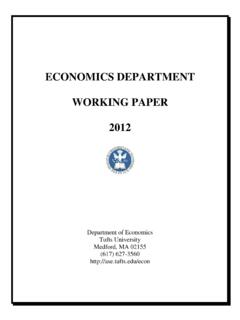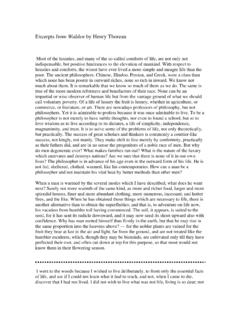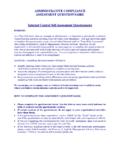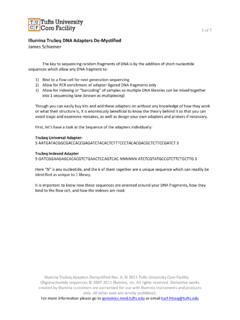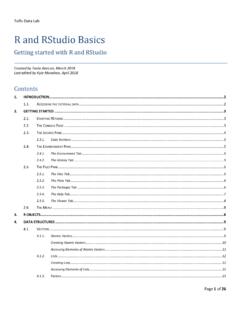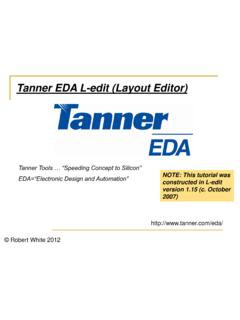Transcription of Using BLAST - Tufts University
1 Using BLAST BLAST (Basic Local Alignment Search Tool) is an online search tool provided by NCBI (National Center for Biotechnology Information). It allows you to find regions of similarity between biological sequences (nucleotide or protein). The NCBI maintains a huge database of biological sequences, which it compares the query sequences to in order to find the most similar ones. Using BLAST , you can input a gene sequence of interest and search entire genomic libraries for identical or similar sequences in a matter of seconds. The amount of information on the BLAST website is a bit overwhelming even for the scientists who use it on a frequent basis! You are not expected to know every detail of the BLAST program. BLAST results have the following fields: E value: The E value (expected value) is a number that describes how many times you would expect a match by chance in a database of that size.
2 The lower the E value is, the more significant the match. Percent Identity: The percent identity is a number that describes how similar the query sequence is to the target sequence (how many characters in each sequence are identical). The higher the percent identity is, the more significant the match. Query Cover: The query cover is a number that describes how much of the query sequence is covered by the target sequence. If the target sequence in the database spans the whole query sequence, then the query cover is 100%. This tells us how long the sequences are, relative to each other. FASTA format FASTA format is used to represent either nucleotide or peptide sequences. The first line is a comment line, beginning with > and describing the sequence. All the following lines are the sequence, in plain text.
3 Example DNA sequence in FASTA format: >gi|23423|ref| | Homo sapiens protein ATGAATCGATACGATAGCTAGCTATCGATGCA GATCAGAGAGGGGCTTTAGCTAGCTAAGCTAG Example protein sequence in FASTA format: >MCHU - Calmodulin - Human, rabbit, bovine, rat, and chicken ADQLTEEQIAEFKEAFSLFDKDGDGTITTKELGTVMRSLG QNPTEAELQDMINEVDADGNGTID FPEFLTMMARKMKDTDSEEEIREAFRVFDKDGNGYISAAE LRHVMTNLGEKLTDEEVDEMIREA DIDGDGQVNYEEFVQMMTAK* Part 1: Identify sequences with BLAST Sequences at Identify unknown sequences 1. Navigate to the main BLAST page ( ) 2. Select the appropriate type of BLAST for your sequence 3. Paste the first unknown sequence into the box (for this activity, you can ignore the search options) 4. Click on the BLAST button and wait for the results. BLAST is usually fairly quick for short sequences, but should still take a few seconds.
4 5. Once the results are displayed, notice there are three main headings: Graphic Summary, Descriptions, and Alignments (these may be expanded so you ll have to scroll down). 6. Use these results to answer the questions below. 7. Repeat steps 1-6 for the other unknown sequence. How is this sequence related to the first sequence? Questions 1. In the Descriptions section, look at the top result, which should be the result with the highest score. Write down information about the best match: Description (no need to write the whole thing) E value Identity Query cover 2. Now scroll down to the Alignments heading. Look at the top result, which should be the same one. Look at the alignment between your query and the reference. Do you see any mismatches? 3. How can you judge whether this is a good match?
5 4. What is this gene? Google the name of the gene and write down something significant you learned about it. Part 2: Investigating sets of sequences Each of the following sets of sequences were obtained from a sequencing experiment. These sequences can be found in the file. For each experiment, answer these questions: What do these sequences have in common? What is your best guess about the original purpose of this experiment? Set 1 >Sequence1a GTAATGTACATAACATTAATGTAATAAAGA >Sequence1b ATCACGAGCTTAATTACCATGCCGCGTGAAACCAGCAACC >Sequence1c ATGGACTAATGGCTAATCAGCCCATGCTCACACATA Set 2 >Sequence2a TTTGGTTGTTCGACGACGGATGCAGAGCTCAGGGAAGTGG GGACGTGTTTTGGCTATCCT >Sequence2b GCGATGCATCAGGATGCATCCTCTGATCTTAGGGTGGTAC GAGAAAAATTGAAGAATGTA >Sequence2c GCGGTTCCACAAGACCCTGAGGCGCCTGGTGCCTGACTCG GACGTCCGGTTCCTCCTCTC Set 3 >Sequence3a TAACCTACGGGTGGCCGCAGTGGGGAATATTGCACAATGG ACACAAGTCTGATGCAGCGACGCCGCGTGGGGGATGAAGG CTTTCGGGTTGTAAACTCCTTTCAGTACAGAAGAAGCATT TTTGTGACGGTATGTGCAGAAGAAGCGCCGGCTAACTACG TGCCAGCAGCCGCGGTAATACGTAGGGCGCGAGCGTTGTC CGGAATTATTGGGCGTAAAGAGCTCGTAGGCGGTTTGTTG CGCCTGCTGTG >Sequence3b
6 TGTCCTACGGGGGGCTGCAGTGAGGAATATTGGTCAATGG GCGAGAGCCTGAACCAGCCAAGTCGCGTGAAGGATGACTG TCTTATGGATTGTAAACTTCTTTTATACGGGAATAACAAG AGTCACGTGTGGCTCCCTGCATGTACCGTATGAATAAGCA TCGGCTAACTCCGTGCCAGCAGCCGCGGTAATACGGAGGA TGCGAGCGTTATCCGGATTTATTGGGTTTAAAGGGTGCGT AGGCGGC >Sequence3c GGCCTACGGGGGGCTGCAGTGGGTACGGGCAGACTAGAGT GTGGTAGGGGTAATTGGAATTCCTGGTGTAGCGGTGGAAT GCGCAGATATCAGGAGGAACACCGATGGCGAAGGCAGGTT ACTGGGCCATTACTGACGCTGAGGAGCGAAAGCGTGGGTA GCGAACAGGATTAGATACCCTAGTAGTCT
